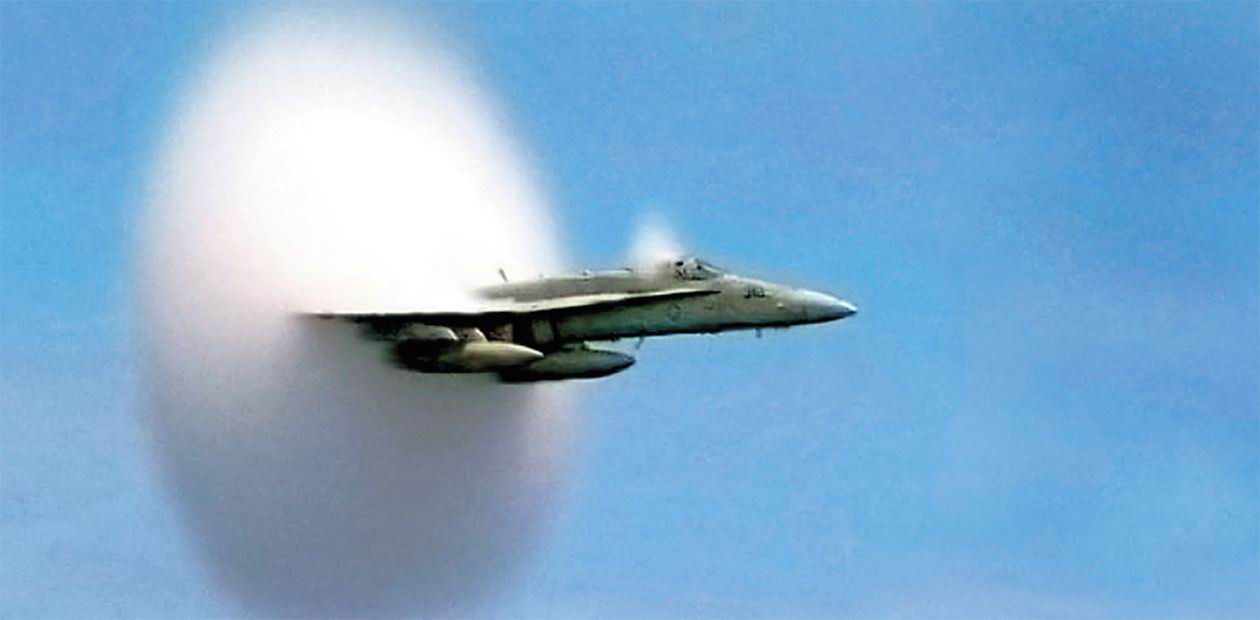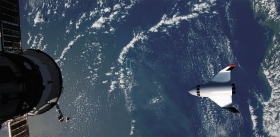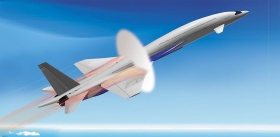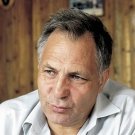Breaking the Sound Barrier
The problems considered by academician Khristianovich have always been important, and many remain ur-gent today. This famous scientist made a significant contribution to the development of high-velocity avia-tion, which served as an impetus for the evolution of new research directions.
Passengers are currently carried on long-range airplanes flying with transonic velocities. The use of supersonic passenger aircrafts will only become possible as the sonic boom problem is successfully resolved.
The range of the cruising flight of a long-range aircraft is proportional to the flight velocity, lift-to-drag ratio, and is inversely proportional to the amount of fuel spent on thrust generation. Naturally, the greater the amount of fuel stored onboard, the longer the flight range. For a fixed flight range, the greater the flight velocity and the greater the lift-to-drag ratio, the smaller the fuel expenses needed.
Activities aimed at increasing the flight velocity and lift-to-drag ratio were started back in the 1930s. At the edge of 1930s—1940s, the aviation science faced new difficult problems posed by the development of high-velocity aviation. An increase in flight velocity was shown to induce a drastic increase in the drag of wings and other aircraft elements. A possible reason for this could be the emergence of flow regions where the air velocities with respect to the streamlined body are higher than the velocity of sound. The opinion popular in Germany and the United States implied that an increase in drag is only caused by separation of the air flow in the rear part of the airfoil, which was induced by the shock wave, a narrow flow region with a drastic decrease from supersonic to subsonic velocity.
In 1940, the team headed by S. A. Khristianovich (who had become head of the High-velocity Aerodynamics Laboratory not long before that time) at the Central Aerohydrodynamic Institute (TsAGI) calculated the drag induced by such shock waves (wave drag) and demonstrated that the drag can reach values recorded in experiments even if there is no flow separation. The shock wave was shown to induce a decrease in pressure in the rear part of the airfoil, and this fact favors an increase in drag of the streamlined body. Flow separation, which often accompanies the shock wave, leads only to an additional decrease in pressure in the same part of the airfoil.
To perform experiments that could validate the theoretical results obtained, it was necessary to create a wind tunnel with a transonic velocity in the test section. In such a facility, the shock waves arising in a transonic flow around the wing model are reflected from the test-section walls, impinge onto the model surface, and change substantially the structure of the air flow.
S.A. Khristianovich developed the theory of short waves, which made it possible to solve the problems of interaction of shock waves with different surfaces. Semipermeable surfaces were found to attenuate the intensity of reflected waves to a large extent. This fact gave rise to the idea of using perforated walls of the test section of the transonic wind tunnel. The first wind tunnel of this kind was created in 1946 in TsAGI. Now wind tunnels with perforated walls are used in aerodynamic laboratories all over the world.
In their later research, Khristianovich and his team succeeded in solving the problem of the influence of flow compressibility on the pressure distribution over the wing in a short time. The fundamental law of stabilization was established. As a critical velocity is reached, the growth rate of velocity near the airfoil surface becomes less intense than the growth rate of the incoming flow velocity. Then the velocity ceases to grow, and the distribution of Mach numbers (the ratio of flight velocity to the velocity of propagation of acoustic waves) over the airfoil surface between its leading edge and the shock wave remains constant and independent of free-stream velocity. Based on this distribution called the limiting distribution of Mach numbers, the limiting pressure curve is calculated.
This law made it possible for Khristianovich to develop a method of calculating aerodynamic characteristics of transonic airfoils. (It should be borne in mind that there were no computers at that time, and all calculations were performed with slide rules or adding machines.)
The idea of controlling the position of the barrel shock stimulated the search for new methods of flow control. It turned out that the position and intensity of the barrel shock can be controlled not only by changing the airfoil shape but also by energy supply to the flow. Calculations showed that it is reasonable to supply very small amounts of energy near the wing surface.
The problems considered by academician Khristianovich have always been important, and many remain urgent today. This famous scientist made a significant contribution to the development of high-velocity aviation, which served as an impetus for the evolution of new research directions.
Academician V. M. Fomin, S. M. Aulchenko, doctor of Physics and Mathematics, and A. F. Latypov, candidate of Technical Sciences (Khristianovich Institute of Theoretical and Applied Mechanics, Siberian Branch, Russian Academy of Sciences, Novosibirsk Scientific Center)

















